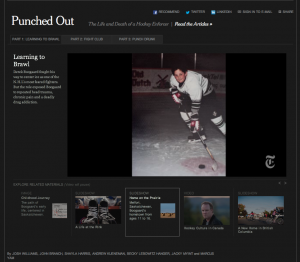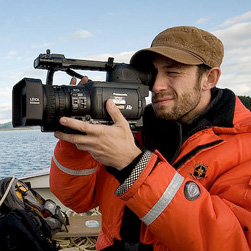Whenever I go out on an assignment I get a few of the same questions from onlookers who see me with my tripod and my reasonably large video camera: “What channel are you from?” or “When will this air?” But my favorite, and the one I get most often after I explain that the video won’t be on TV and that I work not for a channel but for a newspaper website is, “How are they going to get a video into my newspaper?” It’s an old joke by now. Video has graced the websites and mobile offerings of traditionally text-based outlets for nearly a decade.
Video or film storytelling is more than a century old, and print storytelling has a couple of millennia under its belt, but the last few years have brought the two together in exciting and evolving ways, particularly for journalism. Outlets like The Atavist and The Daily, and many newspaper and magazines’ mobile applications, make it possible to seamlessly pogo between a print narrative and snippets of video or a short documentary production. The form is in its infancy but loaded with possibility.
As any writer who has had to wait for a video journalist to get some b-roll knows – and as any video journalist who has wished she could avoid wading through a traditional print reporter’s interviewing knows – collaboration is a dance. For this, the first installment of Viewfinder, an occasional column on video journalism, I talked to a few friends and colleagues about the pleasures and pains of building video and print packages. It’s a common conversation, one I’ve had over lunch at work and on long car rides with fellow print reporters. It’s fair to say that most agree the product is a richer audience experience, but how we get there is still being worked out. I hope this column will be a place to parse this and other aspects of the burgeoning craft of web and mobile-based nonfiction video reporting.
 Let’s start with what works. I’ve seen terrific packages, many of them big blowouts like the L.A. Times’ series about the effects of the recession, or the Detroit Free Press’ Motown retrospective. The Seattle Times did a laudable job with its in-depth look at the removal of two dams on the Elwha River.
Let’s start with what works. I’ve seen terrific packages, many of them big blowouts like the L.A. Times’ series about the effects of the recession, or the Detroit Free Press’ Motown retrospective. The Seattle Times did a laudable job with its in-depth look at the removal of two dams on the Elwha River.
How you make all the parts work together is no small challenge. I talked with my New York Times colleague Shayla Harris, who spent a good four months laboring, along with the photographer Marcus Yam and the reporter John Branch, to weave text, video and photos together to tell the story of the life and death of professional hockey enforcer Derek Boogaard. Ten or 15 years ago, the story would have been a terrific package at a paper – exhaustive reporting, stellar photography, maybe some good graphics. A few weeks or months later, a TV station or an independent documentary filmmaker might start in on a video/film project. Harris, who started at NBC News as an assistant/associate producer, confirmed as much: “A lot of our stories would basically be ripped from the pages of the New York Times. So, right now, we’re basically the in-house version of that. Unfortunately, when you’re working alongside a reporter you don’t get the benefit of having a finished story in front of you to work from.”
Harris also didn’t have much footage to work with, but when the team approached the Boogaard family about telling Derek’s story, the “floodgates” as she put it, opened up. The family had handwritten diaries, some from Derek’s earliest bouts, plus scrapbooks of newspaper clippings about Derek, family photo albums and perhaps most valuable, eight DVDs of every fight Derek had been in from his time in the Canadian Junior League until he landed in the NHL.
 Though Branch relied on the same fight material to flesh out scenes in his print story (and were included in a pop-up version called a “quick-link” for mobile and web audiences) the videos felt distinct and complementary rather than duplicative. Harris explained that she felt like Branch’s story could handle the contextual aspects of the story and that her job would be to create a visceral experience for the viewer. “The thing that video can do, that words sometimes can’t, is … evoke a mood or feeling on a multisensory level,” she said. “Just hearing the inflection in someone’s voice and the way they say things can convey a lot of information.”
Though Branch relied on the same fight material to flesh out scenes in his print story (and were included in a pop-up version called a “quick-link” for mobile and web audiences) the videos felt distinct and complementary rather than duplicative. Harris explained that she felt like Branch’s story could handle the contextual aspects of the story and that her job would be to create a visceral experience for the viewer. “The thing that video can do, that words sometimes can’t, is … evoke a mood or feeling on a multisensory level,” she said. “Just hearing the inflection in someone’s voice and the way they say things can convey a lot of information.”
Video can convey emotion with much greater power than a text quote can. You can see this in Harris’s videos, especially in the interviews with Boogaard’s fellow enforcers. They’re big, imposing men whose job is to intimidate and often to bare-knuckle box on the ice, and their recollections of Boogaard are powerful.
That acknowledgment of video’s strengths has also worked well for my friend Erik German and his wife, Solana Pyne. German works for The Daily as a text reporter, but he’s always thinking about ways to make video work. “In our shop, video is just part of the production process, but there are three major areas that are suddenly very different,” he said.
The three areas: planning, execution and assembly.
“Each of those is a lot more complicated if video is involved,” he said. German argues if you’re really going to have video be a part of the story, reporters need to know from the beginning, for the best possible outcome. This entails thinking about everything from the pitch to the questions you ask a source before you leave the office – quite different than if you’re headed out with just a pen and pad. He says, “I find myself now asking TV producer questions like, ‘What does it look like when you do your job? If I followed you around all day, what would I see?’”
Print reporters rarely ask a source they’re going to visit what the inside of someone’s office is like or if it gets good light in the afternoon or if there’s anything noisy going on that might make doing a recorded interview difficult, but those are all concerns for a video journalist. Yet thinking about those challenges as a text-based reporter can help set up a good video collaboration.
One of my favorite pieces by German, with great videos produced by Pyne, is about a new law in Texas that made it legal to hunt feral hogs from helicopters. They interviewed game officials, farmers upset by the damage the hogs cause to land, and representatives from the two camps of hog eradication. The hunters and the trappers were all convinced their differing methods were superior.
One aspect of the story they hadn’t counted on was a heat wave that sent the hogs deep into the brush, nowhere to be seen. “You could do a print story about a hog infestation even if you don’t see any hogs,” German said, “but for a video you’ve got to see the pigs.” Yet you’d never know about the missing pigs to read German’s story or to watch Pyne’s videos, in part because they artfully used what footage they could shoot, including material from small-action sports cameras mounted on the stocks of rifles. They bought a bit of stock material from a local shooter and had some great material of very clever hogs working their ways out of traps.
The Daily, which is designed from the ground up every day, elegantly meshes video and text and, like the Boogaard series, uses shorter embedded elements to good effect – “like visual and aural snapshots,” as Pyne puts it. “They conveyed things that would have been hard to get across any other way.”
The effect is, I think, one of the best ways to meld video into a print story. Texan twang and drawl about the difficulty of hog hunting came across in little snippets of video that might not have had a home in the bigger video story, and when transcribed for print might have lost their punch.
Pyne also does a lot of thinking about what makes for good video and print. She’s a senior video producer at GlobalPost, which produces a good deal of video, sometimes as a standalone report. She assigns many of the video journalists; most are freelancers who work on GlobalPost packages, often in tandem with a staff reporter. She often tells video journalists to follow their instincts. “I think it’s important to ensure that the print reporter doesn’t take over the story, because then you get a video that’s just like the print piece,” she said. “It’s useful to have them work together, but I want the videographer to feel comfortable leaving (or staying) to get good video.”
I recommend a deep read and watch on the touching series she helped put together from Japan shortly after the earthquake and the nuclear disaster. Like many of the best collaborations, the text stories anchors the bigger-picture thoughts and the video focuses on characters: everyday Japanese people whose lives were upended.
 Sean Patrick Farrell (@spatrickfarrell) is a staff video journalist at the New York Times. He has made videos about tracking wolverines in Montana, dangerous medical radiation and aspiring young opera singers, among many others. He is a graduate of the University of California Berkeley’s Graduate School of Journalism, where he studied documentary film. Before becoming a journalist, he spent a decade working as a bicycle mechanic. You can find more of his work at www.seanpatrickfarrell.com. This is his inaugural Viewfinder column for Storyboard.
Sean Patrick Farrell (@spatrickfarrell) is a staff video journalist at the New York Times. He has made videos about tracking wolverines in Montana, dangerous medical radiation and aspiring young opera singers, among many others. He is a graduate of the University of California Berkeley’s Graduate School of Journalism, where he studied documentary film. Before becoming a journalist, he spent a decade working as a bicycle mechanic. You can find more of his work at www.seanpatrickfarrell.com. This is his inaugural Viewfinder column for Storyboard.



